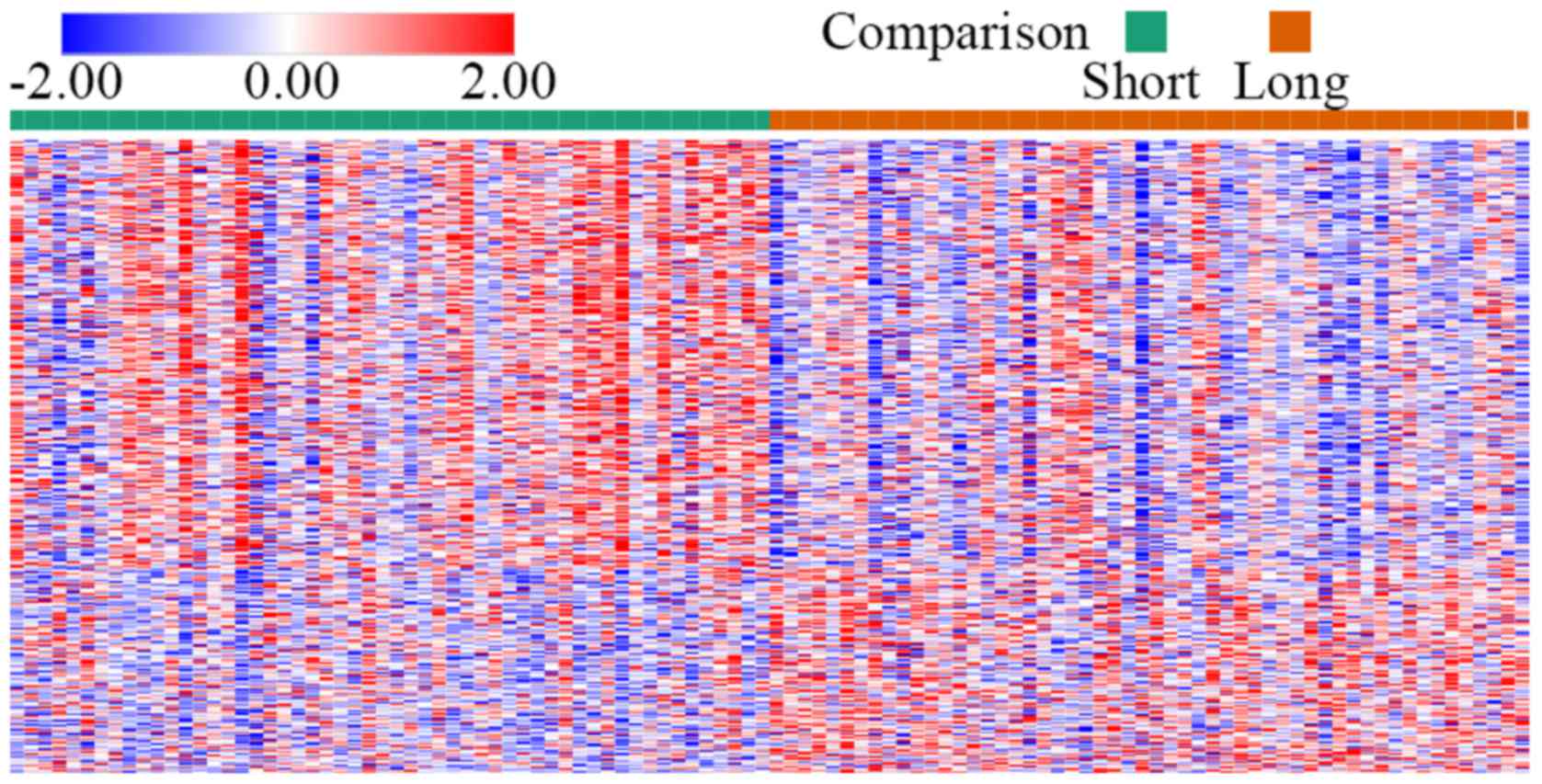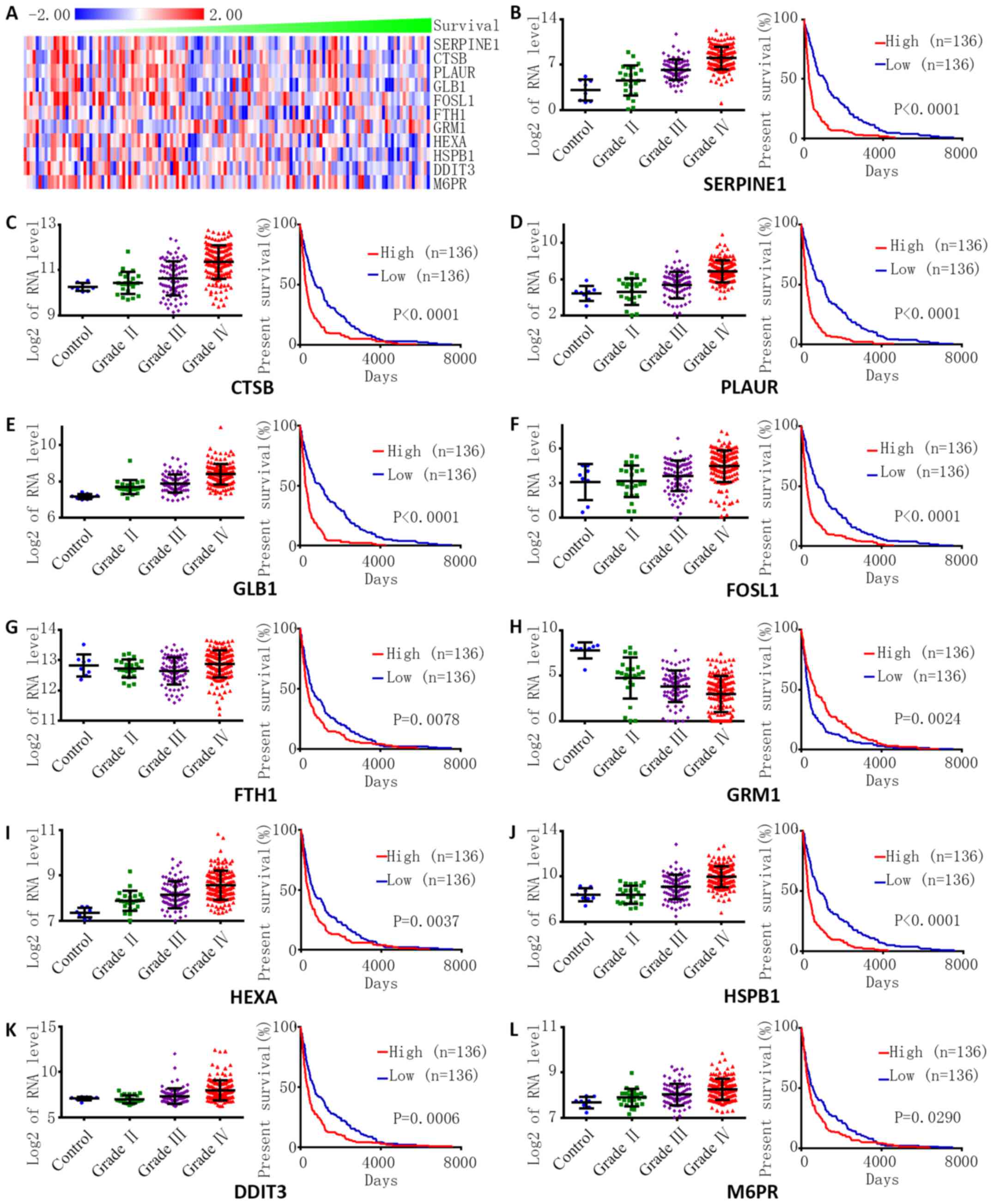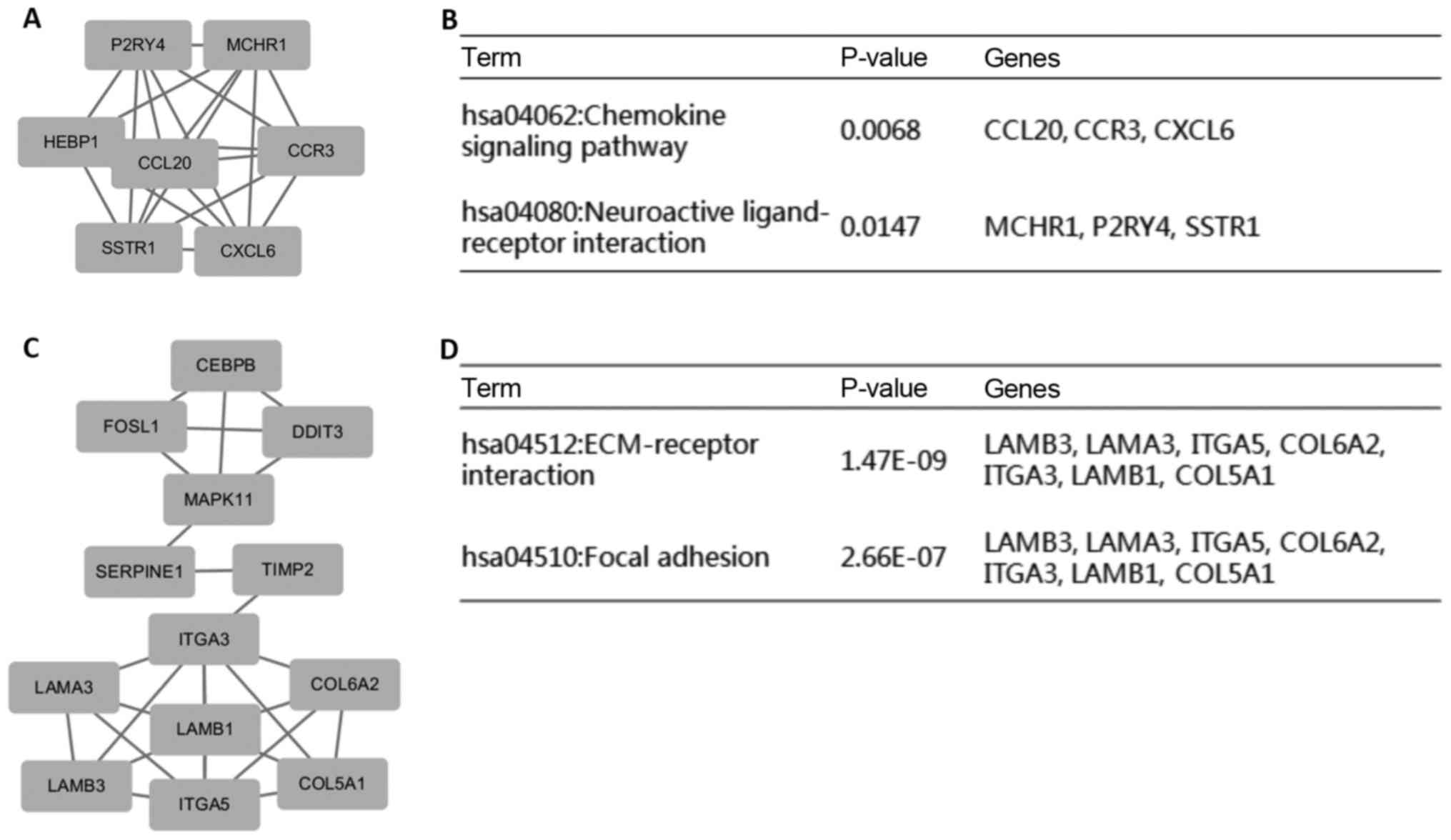|
1
|
Ostrom QT, Gittleman H, Fulop J, Liu M,
Blanda R, Kromer C, Wolinsky Y, Kruchko C and Barnholtz-Sloan JS:
CBTRUS Statistical Report: Primary Brain and Central Nervous System
Tumors Diagnosed in the United States in 2008–2012. Neuro Oncol. 17
Suppl 4:iv1–iv62. 2015. View Article : Google Scholar : PubMed/NCBI
|
|
2
|
Nabors LB, Portnow J, Ammirati M, Baehring
J, Brem H, Brown P, Butowski N, Chamberlain MC, Fenstermaker RA,
Friedman A, et al: Central Nervous System Cancers, Version 1.2015.
J Natl Compr Canc Netw. 13:1191–1202. 2015. View Article : Google Scholar : PubMed/NCBI
|
|
3
|
Venteicher AS, Tirosh I, Hebert C, Yizhak
K, Neftel C, Filbin MG, Hovestadt V, Escalante LE, Shaw ML, Rodman
C, et al: Decoupling genetics, lineages, and microenvironment in
IDH-mutant gliomas by single-cell RNA-seq. Science. 355:3552017.
View Article : Google Scholar : PubMed/NCBI
|
|
4
|
Brennan CW, Verhaak RG, McKenna A, Campos
B, Noushmehr H, Salama SR, Zheng S, Chakravarty D, Sanborn JZ,
Berman SH, et al: TCGA Research Network: The somatic genomic
landscape of glioblastoma. Cell. 155:462–477. 2013. View Article : Google Scholar : PubMed/NCBI
|
|
5
|
Verhaak RG, Hoadley KA, Purdom E, Wang V,
Qi Y, Wilkerson MD, Miller CR, Ding L, Golub T, Mesirov JP, et al:
Cancer Genome Atlas Research Network: Integrated genomic analysis
identifies clinically relevant subtypes of glioblastoma
characterized by abnormalities in PDGFRA, IDH1, EGFR, and
NF1. Cancer Cell. 17:98–110. 2010. View Article : Google Scholar : PubMed/NCBI
|
|
6
|
Stupp R, Mason WP, van den Bent MJ, Weller
M, Fisher B, Taphoorn MJ, Belanger K, Brandes AA, Marosi C, Bogdahn
U, et al: European Organisation for Research and Treatment of
Cancer Brain Tumor and Radiotherapy Groups; National Cancer
Institute of Canada Clinical Trials Group: Radiotherapy plus
concomitant and adjuvant temozolomide for glioblastoma. N Engl J
Med. 352:987–996. 2005. View Article : Google Scholar : PubMed/NCBI
|
|
7
|
Klein CA: Framework models of tumor
dormancy from patient-derived observations. Curr Opin Genet Dev.
21:42–49. 2011. View Article : Google Scholar : PubMed/NCBI
|
|
8
|
Goss PE and Chambers AF: Does tumour
dormancy offer a therapeutic target? Nat Rev Cancer. 10:871–877.
2010. View
Article : Google Scholar : PubMed/NCBI
|
|
9
|
Aguirre-Ghiso JA: Models, mechanisms and
clinical evidence for cancer dormancy. Nat Rev Cancer. 7:834–846.
2007. View
Article : Google Scholar : PubMed/NCBI
|
|
10
|
Sosa MS, Bragado P and Aguirre-Ghiso JA:
Mechanisms of disseminated cancer cell dormancy: An awakening
field. Nat Rev Cancer. 14:611–622. 2014. View Article : Google Scholar : PubMed/NCBI
|
|
11
|
Ishii A, Kimura T, Sadahiro H, Kawano H,
Takubo K, Suzuki M and Ikeda E: Histological characterization of
the tumorigenic ‘peri-necrotic niche’ harboring quiescent stem-like
tumor cells in glioblastoma. PLoS One. 11:e01473662016. View Article : Google Scholar : PubMed/NCBI
|
|
12
|
Jain RK, di Tomaso E, Duda DG, Loeffler
JS, Sorensen AG and Batchelor TT: Angiogenesis in brain tumours.
Nat Rev Neurosci. 8:610–622. 2007. View
Article : Google Scholar : PubMed/NCBI
|
|
13
|
Tate MC and Aghi MK: Biology of
angiogenesis and invasion in glioma. Neurotherapeutics. 6:447–457.
2009. View Article : Google Scholar : PubMed/NCBI
|
|
14
|
Jhaveri N, Chen TC and Hofman FM: Tumor
vasculature and glioma stem cells: Contributions to glioma
progression. Cancer Lett. 380:545–551. 2016. View Article : Google Scholar : PubMed/NCBI
|
|
15
|
Huang Y, Tong L, Yi L, Zhang C, Hai L, Li
T, Yu S, Wang W, Tao Z, Ma H, et al: Three-dimensional hydrogel is
suitable for targeted investigation of amoeboid migration of glioma
cells. Mol Med Rep. 17:250–256. 2018.PubMed/NCBI
|
|
16
|
Sang L, Roberts JM and Coller HA:
Hijacking HES1: How tumors co-opt the anti-differentiation
strategies of quiescent cells. Trends Mol Med. 16:17–26. 2010.
View Article : Google Scholar : PubMed/NCBI
|
|
17
|
Sosa MS, Parikh F, Maia AG, Estrada Y,
Bosch A, Bragado P, Ekpin E, George A, Zheng Y, Lam HM, et al:
NR2F1 controls tumour cell dormancy via SOX9- and RARβ-driven
quiescence programmes. Nat Commun. 6:61702015. View Article : Google Scholar : PubMed/NCBI
|
|
18
|
Kondapalli KC, Llongueras JP,
Capilla-González V, Prasad H, Hack A, Smith C, Guerrero-Cázares H,
Quiñones-Hinojosa A and Rao R: A leak pathway for luminal protons
in endosomes drives oncogenic signalling in glioblastoma. Nat
Commun. 6:62892015. View Article : Google Scholar : PubMed/NCBI
|
|
19
|
Noreen R, Moenner M, Hwu Y and Petibois C:
FTIR spectro-imaging of collagens for characterization and grading
of gliomas. Biotechnol Adv. 30:1432–1446. 2012. View Article : Google Scholar : PubMed/NCBI
|
|
20
|
Desgrosellier JS and Cheresh DA: Integrins
in cancer: Biological implications and therapeutic opportunities.
Nat Rev Cancer. 10:9–22. 2010. View
Article : Google Scholar : PubMed/NCBI
|
|
21
|
Kawabe H, Neeb A, Dimova K, Young SM Jr,
Takeda M, Katsurabayashi S, Mitkovski M, Malakhova OA, Zhang DE,
Umikawa M, et al: Regulation of Rap2A by the ubiquitin ligase
Nedd4-1 controls neurite development. Neuron. 65:358–372. 2010.
View Article : Google Scholar : PubMed/NCBI
|
|
22
|
Schwamborn JC and Püschel AW: The
sequential activity of the GTPases Rap1B and Cdc42 determines
neuronal polarity. Nat Neurosci. 7:923–929. 2004. View Article : Google Scholar : PubMed/NCBI
|
|
23
|
Barrett A, Evans IM, Frolov A, Britton G,
Pellet-Many C, Yamaji M, Mehta V, Bandopadhyay R, Li N, Brandner S,
et al: A crucial role for DOK1 in PDGF-BB-stimulated glioma cell
invasion through p130Cas and Rap1 signalling. J Cell Sci.
127:2647–2658. 2014. View Article : Google Scholar : PubMed/NCBI
|
|
24
|
Colin C, Voutsinos-Porche B, Nanni I, Fina
F, Metellus P, Intagliata D, Baeza N, Bouvier C, Delfino C, Loundou
A, et al: High expression of cathepsin B and plasminogen activator
inhibitor type-1 are strong predictors of survival in
glioblastomas. Acta Neuropathol. 118:745–754. 2009. View Article : Google Scholar : PubMed/NCBI
|
|
25
|
Roy A, Coum A, Marinescu VD, Põlajeva J,
Smits A, Nelander S, Uhrbom L, Westermark B, Forsberg-Nilsson K,
Pontén F, et al: Glioma-derived plasminogen activator inhibitor-1
(PAI-1) regulates the recruitment of LRP1 positive mast cells.
Oncotarget. 6:23647–23661. 2015. View Article : Google Scholar : PubMed/NCBI
|
|
26
|
Hu J, Muller KA, Furnari FB, Cavenee WK,
VandenBerg SR and Gonias SL: Neutralizing the EGF receptor in
glioblastoma cells stimulates cell migration by activating
uPAR-initiated cell signaling. Oncogene. 34:4078–4088. 2015.
View Article : Google Scholar : PubMed/NCBI
|
|
27
|
Raghu H, Gondi CS, Dinh DH, Gujrati M and
Rao JS: Specific knockdown of uPA/uPAR attenuates invasion in
glioblastoma cells and xenografts by inhibition of cleavage and
trafficking of Notch-1 receptor. Mol Cancer. 10:1302011. View Article : Google Scholar : PubMed/NCBI
|
|
28
|
Gopinath S, Malla R, Alapati K, Gorantla
B, Gujrati M, Dinh DH and Rao JS: Cathepsin B and uPAR regulate
self-renewal of glioma-initiating cells through GLI-regulated Sox2
and Bmi1 expression. Carcinogenesis. 34:550–559. 2013. View Article : Google Scholar : PubMed/NCBI
|
|
29
|
Malla Rao R, Gopinath S, Alapati K,
Gorantla B, Gondi CS and Rao JS: Knockdown of cathepsin B and uPAR
inhibits CD151 and α3β1 integrin-mediated cell adhesion and
invasion in glioma. Mol Carcinog. 52:777–790. 2013.PubMed/NCBI
|
|
30
|
Malla RR, Gopinath S, Alapati K, Gorantla
B, Gondi CS and Rao JS: uPAR and cathepsin B inhibition enhanced
radiation-induced apoptosis in gliomainitiating cells. Neuro Oncol.
14:745–760. 2012. View Article : Google Scholar : PubMed/NCBI
|
|
31
|
Coquerel B, Poyer F, Torossian F, Dulong
V, Bellon G, Dubus I, Reber A and Vannier JP: Elastin-derived
peptides: Matrikines critical for glioblastoma cell aggressiveness
in a 3-D system. Glia. 57:1716–1726. 2009. View Article : Google Scholar : PubMed/NCBI
|
|
32
|
Debinski W and Gibo DM: Fos-related
antigen 1 (Fra-1) pairing with and transactivation of JunB in GBM
cells. Cancer Biol Ther. 11:254–262. 2011. View Article : Google Scholar : PubMed/NCBI
|
|
33
|
Belguise K, Cherradi S, Sarr A, Boissière
F, Boulle N, Simony-Lafontaine J, Choesmel-Cadamuro V, Wang X and
Chalbos D: PKCθ-induced phosphorylations control the ability of
Fra-1 to stimulate gene expression and cancer cell migration.
Cancer Lett. 385:97–107. 2017. View Article : Google Scholar : PubMed/NCBI
|
|
34
|
Tam WL, Lu H, Buikhuisen J, Soh BS, Lim E,
Reinhardt F, Wu ZJ, Krall JA, Bierie B, Guo W, et al: Protein
kinase C α is a central signaling node and therapeutic target for
breast cancer stem cells. Cancer Cell. 24:347–364. 2013. View Article : Google Scholar : PubMed/NCBI
|
|
35
|
Thompson KJ, Fried MG, Ye Z, Boyer P and
Connor JR: Regulation, mechanisms and proposed function of ferritin
translocation to cell nuclei. J Cell Sci. 115:2165–2177.
2002.PubMed/NCBI
|
|
36
|
Liu X, Madhankumar AB, Slagle-Webb B,
Sheehan JM, Surguladze N and Connor JR: Heavy chain ferritin siRNA
delivered by cationic liposomes increases sensitivity of cancer
cells to chemotherapeutic agents. Cancer Res. 71:2240–2249. 2011.
View Article : Google Scholar : PubMed/NCBI
|
|
37
|
Lobello N, Biamonte F, Pisanu ME, Faniello
MC, Jakopin Ž, Chiarella E, Giovannone ED, Mancini R, Ciliberto G,
Cuda G, et al: Ferritin heavy chain is a negative regulator of
ovarian cancer stem cell expansion and epithelial to mesenchymal
transition. Oncotarget. 7:62019–62033. 2016. View Article : Google Scholar : PubMed/NCBI
|
|
38
|
Zhang C, Yuan XR, Li HY, Zhao ZJ, Liao YW,
Wang XY, Su J, Sang SS and Liu Q: Anti-cancer effect of
metabotropic glutamate receptor 1 inhibition in human glioma U87
cells: Involvement of PI3K/Akt/mTOR pathway. Cell Physiol Biochem.
35:419–432. 2015. View Article : Google Scholar : PubMed/NCBI
|
|
39
|
Brattain MG, Green C, Kimball PM, Marks M
and Khaled M: Isoenzymes of beta-hexosaminidase from normal rat
colon and colonic carcinoma. Cancer Res. 39:4083–4090.
1979.PubMed/NCBI
|
|
40
|
Chatterjee SK, Chowdhury K, Bhattacharya M
and Barlow JJ: Beta-hexosaminidase activities and isoenzymes in
normal human ovary and ovarian adenocarcinoma. Cancer. 49:128–135.
1982. View Article : Google Scholar : PubMed/NCBI
|
|
41
|
Narita M, Taniguchi N, Makita A, Kodama T,
Araki E and Oikawa K: Elevated activity of beta-hexosaminidase and
sulfhydryl modification in the B-variant of human lung cancer.
Cancer Res. 43:5037–5042. 1983.PubMed/NCBI
|
|
42
|
Gimenez M, Marie SK, Oba-Shinjo S, Uno M,
Izumi C, Oliveira JB and Rosa JC: Quantitative proteomic analysis
shows differentially expressed HSPB1 in glioblastoma as a
discriminating short from long survival factor and NOVA1 as a
differentiation factor between low-grade astrocytoma and
oligodendroglioma. BMC Cancer. 15:4812015. View Article : Google Scholar : PubMed/NCBI
|
|
43
|
Golembieski WA, Thomas SL, Schultz CR,
Yunker CK, McClung HM, Lemke N, Cazacu S, Barker T, Sage EH, Brodie
C, et al: HSP27 mediates SPARC-induced changes in glioma
morphology, migration, and invasion. Glia. 56:1061–1075. 2008.
View Article : Google Scholar : PubMed/NCBI
|
|
44
|
Schultz CR, Golembieski WA, King DA, Brown
SL, Brodie C and Rempel SA: Inhibition of HSP27 alone or in
combination with pAKT inhibition as therapeutic approaches to
target SPARC-induced glioma cell survival. Mol Cancer. 11:202012.
View Article : Google Scholar : PubMed/NCBI
|
|
45
|
Rouschop KM, van den Beucken T, Dubois L,
Niessen H, Bussink J, Savelkouls K, Keulers T, Mujcic H, Landuyt W,
Voncken JW, et al: The unfolded protein response protects human
tumor cells during hypoxia through regulation of the autophagy
genes MAP1LC3B and ATG5. J Clin Invest. 120:127–141. 2010.
View Article : Google Scholar : PubMed/NCBI
|
|
46
|
Liu WT, Huang CY, Lu IC and Gean PW:
Inhibition of glioma growth by minocycline is mediated through
endoplasmic reticulum stress-induced apoptosis and autophagic cell
death. Neuro Oncol. 15:1127–1141. 2013. View Article : Google Scholar : PubMed/NCBI
|
|
47
|
Thevenot PT, Sierra RA, Raber PL, Al-Khami
AA, Trillo-Tinoco J, Zarreii P, Ochoa AC, Cui Y, Del Valle L and
Rodriguez PC: The stress-response sensor chop regulates the
function and accumulation of myeloid-derived suppressor cells in
tumors. Immunity. 41:389–401. 2014. View Article : Google Scholar : PubMed/NCBI
|
|
48
|
Ahmed KA, Wang L, Griebel P, Mousseau DD
and Xiang J: Differential expression of mannose-6-phosphate
receptor regulates T cell contraction. J Leukoc Biol. 98:313–318.
2015. View Article : Google Scholar : PubMed/NCBI
|
|
49
|
Luo S, Jing L, Zhao T, Li Y, Liu Z and
Diao A: Ubiquitination and dynactin regulate TMEPAI lysosomal
trafficking. Sci Rep. 7:426682017. View Article : Google Scholar : PubMed/NCBI
|
|
50
|
Somasundaram R and Herlyn D: Chemokines
and the microenvironment in neuroectodermal tumor-host interaction.
Semin Cancer Biol. 19:92–96. 2009. View Article : Google Scholar : PubMed/NCBI
|
|
51
|
Barbieri F, Pattarozzi A, Gatti M, Aiello
C, Quintero A, Lunardi G, Bajetto A, Ferrari A, Culler MD and
Florio T: Differential efficacy of SSTR1, −2, and −5 agonists in
the inhibition of C6 glioma growth in nude mice. Am J Physiol
Endocrinol Metab. 297:E1078–E1088. 2009. View Article : Google Scholar : PubMed/NCBI
|
|
52
|
Barbieri F, Pattarozzi A, Gatti M, Porcile
C, Bajetto A, Ferrari A, Culler MD and Florio T: Somatostatin
receptors 1, 2, and 5 cooperate in the somatostatin inhibition of
C6 glioma cell proliferation in vitro via a phosphotyrosine
phosphatase-eta-dependent inhibition of extracellularly regulated
kinase-1/2. Endocrinology. 149:4736–4746. 2008. View Article : Google Scholar : PubMed/NCBI
|
|
53
|
Venkatesh HS, Johung TB, Caretti V, Noll
A, Tang Y, Nagaraja S, Gibson EM, Mount CW, Polepalli J, Mitra SS,
et al: Neuronal Activity Promotes Glioma Growth through
Neuroligin-3 Secretion. Cell. 161:803–816. 2015. View Article : Google Scholar : PubMed/NCBI
|
|
54
|
Lyu T, Jia N, Wang J, Yan X, Yu Y, Lu Z,
Bast RC Jr, Hua K and Feng W: Expression and epigenetic regulation
of angiogenesis-related factors during dormancy and recurrent
growth of ovarian carcinoma. Epigenetics. 8:1330–1346. 2013.
View Article : Google Scholar : PubMed/NCBI
|

















